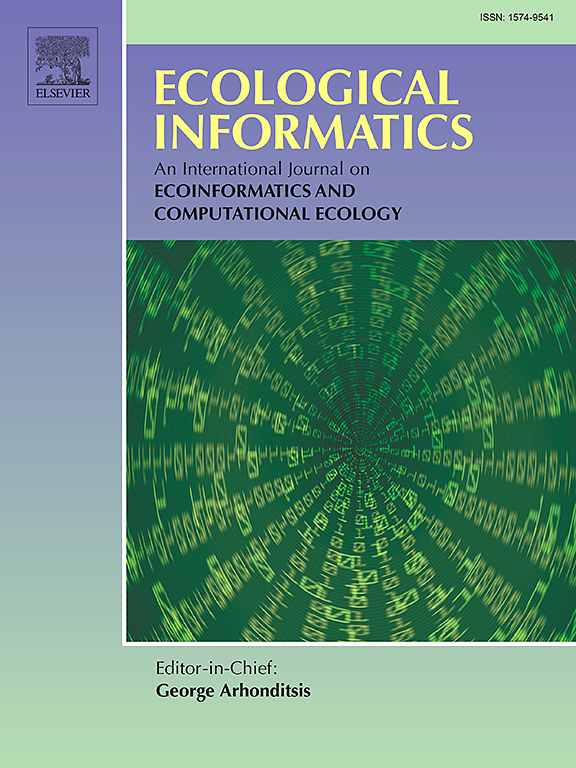亚洲岩溶集中分布区植被生态系统碳汇的变化及其对干旱的响应
IF 5.8
2区 环境科学与生态学
Q1 ECOLOGY
引用次数: 0
摘要
岩溶地区生态系统净生产力(NEP)的变化会对陆地生态系统的碳循环产生重大影响,但由于其特殊的气候和水文条件,量化植被NEP的变化及其对干旱和水文气候等因素的响应仍是一项艰巨的挑战。我们利用遥感数据估算了亚洲喀斯特集中分布区(AKC)的植被NEP,分析了其每年(2000-2020年)和雨季(5-11月)的时空变化,建立了干旱荧光监测指数(DFMI),并利用山脊回归模型探讨了植被NEP对干湿条件响应机制。结果表明(1)与全年变化相比,雨季植被NEP的变化在喀斯特地理分区上存在显著差异,其中中国西南(SC)及其喀斯特地区呈显著上升趋势,而印度支那半岛(IP)及其喀斯特地区呈显著下降趋势。(2)DFMI 是植被 NEP 变化的主要驱动因子,其在年尺度和雨季的贡献率分别为 38.05% 和 32.82%,驱动了西南地区植被 NEP 的增加和中南半岛植被 NEP 的减少;值得注意的是,水汽压差(VPD)的增加是导致中南半岛岩溶地区雨季植被 NEP 减少的关键因素。(3) 在干旱对植被 NEP 的滞后效应中,发现滞后的时间尺度为 1 个月。该研究揭示了不同喀斯特地理分区植被碳汇变化的差异。我们得到了一个新的发现:受 DFMI 和 VPD 变化的长期影响,IP 及其岩溶地区的植被 NEP 呈显著下降趋势。因此,在岩溶地区的碳循环调节和植被恢复工作中,应考虑不同岩溶地区的差异性以及干旱和水资源的变化。本文章由计算机程序翻译,如有差异,请以英文原文为准。
Changes in vegetation ecosystem carbon sinks and their response to drought in the karst concentration distribution area of Asia
Changes in net ecosystem productivity (NEP) in karst areas can have a significant impact on terrestrial ecosystem carbon cycling, yet quantifying changes in vegetation NEP and its response to factors such as drought and hydroclimate remains a difficult challenge because of its special climatic and hydrological conditions. We used remote sensing data to estimate vegetation NEP in the Asian karst concentrated distribution area (AKC), analyzed its spatial and temporal variations annually (2000−2020) and during rainy season (May–November), established the drought fluorescence monitoring index (DFMI), and used a ridge regression model to explore the response mechanism of vegetation NEP to dry and wet conditions response mechanism. The results showed the following: (1) Compared with the annual changes, the vegetation NEP changes in the rainy season differed significantly on the karst geographic divisions, in which there was a significant increasing trend in Southwest China (SC) and its karst areas, while a significant decreasing trend in the Indochina Peninsula (IP) and its karst areas. (2) DFMI was the main driver of vegetation NEP change, of which the contributions were 38.05 % and 32.82 % at the annual scale and in the rainy season, respectively, which drove the increase in SC vegetation NEP, and the decrease in IP; note that the increase in vapor pressure deficit (VPD) was the key factor causing the decrease in NEP in the IP karst area during the rainy season. (3) In the lagged effect of drought on vegetation NEP, the time scale of the lag was found to be 1 month. The study revealed differences in the changes in the vegetation carbon sinks in different karst geographic divisions. We obtained a new finding: a significant trend of decreasing vegetation NEP in the IP and its karst area was influenced by the long-term effects of changes in DFMI and VPD. Therefore, the variability of different karst areas, as well as changes in drought and water resources, should be considered in carbon-cycle regulation and vegetation restoration efforts in karst areas.
求助全文
通过发布文献求助,成功后即可免费获取论文全文。
去求助
来源期刊

Ecological Informatics
环境科学-生态学
CiteScore
8.30
自引率
11.80%
发文量
346
审稿时长
46 days
期刊介绍:
The journal Ecological Informatics is devoted to the publication of high quality, peer-reviewed articles on all aspects of computational ecology, data science and biogeography. The scope of the journal takes into account the data-intensive nature of ecology, the growing capacity of information technology to access, harness and leverage complex data as well as the critical need for informing sustainable management in view of global environmental and climate change.
The nature of the journal is interdisciplinary at the crossover between ecology and informatics. It focuses on novel concepts and techniques for image- and genome-based monitoring and interpretation, sensor- and multimedia-based data acquisition, internet-based data archiving and sharing, data assimilation, modelling and prediction of ecological data.
 求助内容:
求助内容: 应助结果提醒方式:
应助结果提醒方式:


